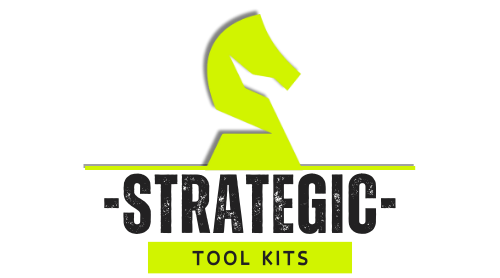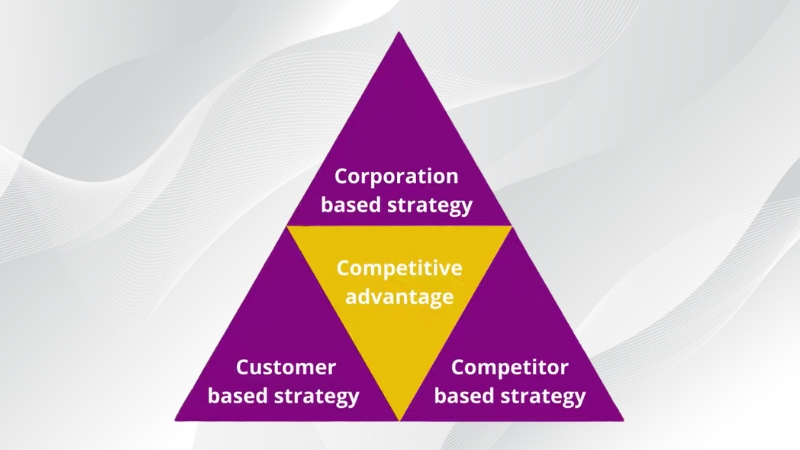In business strategy, success is rarely the result of a single advantage; it’s about balance. The best-performing companies consistently align three critical forces: their customers, their competitors, and their own capabilities.
This idea is captured perfectly by the Strategic Triangle Framework, also known as Ohmae’s 3Cs Model. Developed by Japanese management consultant Kenichi Ohmae, it remains one of the most enduring tools for understanding how to create and sustain competitive advantage.
At its core, the Strategic Triangle argues that every successful strategy must strike a balance among three Cs:
If any one corner of that triangle is ignored, the strategy loses coherence. The framework helps managers evaluate their position, define value propositions, and make choices that strengthen competitive standing in dynamic markets.
What Is the Strategic Triangle Framework?
The Strategic Triangle Framework provides a structured way to analyze how a company can achieve long-term success through differentiation, customer focus, and superior resource alignment.
Kenichi Ohmae, often called Japan’s “Mr. Strategy,” introduced this model to illustrate how companies can compete effectively without relying solely on cost-cutting or scale.
According to Ohmae:
“The key to success lies in achieving superior value by optimizing the relationships among the company, the customer, and the competitor.”
Here’s how the three elements interact:
Element (C)
Focus
Goal
Key Question
Company
Internal capabilities, strengths, and resources
Leverage what we do best
“What can we offer that others can’t?”
Customer
Needs, preferences, and behaviors
Deliver superior value
“What does the customer truly care about?”
Competitor
Rivals’ positioning, strengths, and strategies
Differentiate effectively
“How do we stand apart from them?”
The strategic triangle insists that companies continuously adjust their strategy to maintain equilibrium across these three forces, because when one changes, the other two must respond.
The Three Key Components Explained

1. The Company: Capabilities and Resources
The first corner of the triangle focuses inward on your company’s strengths, competencies, assets, and internal processes. This includes technology, people, financial resources, culture, brand, and operational efficiency.
Your company strategy should capitalize on its unique capabilities, not try to imitate competitors. True advantage comes from distinctiveness, not sameness.
Key Dimensions
Examples
Core Competencies
Product design, logistics, innovation, customer support
Financial Strength
Access to capital, investment capacity
Brand Equity
Market trust, reputation, loyalty
Technology & R&D
Patents, proprietary tools, digital platforms
Culture & Leadership
Decision-making speed, creativity, and empowerment
2. The Customer: Understanding and Creating Value
@tonyrobbins Success in business doesn’t start with a product or service, but a focus on the client’s needs. Make it all about them. #business #businesstips ♬ Getting Better – Danilo Stankovic
At the heart of any strategy lies the customer. According to Ohmae, customer-centered thinking is the foundation of lasting success.
The goal is to understand customers deeply, their unmet needs, emotional motivations, and decision-making drivers, and design offerings that deliver superior value compared to alternatives.
Customer Dimension
Focus Area
Example
Segmentation
Identify distinct customer groups
B2B vs. consumer markets
Value Proposition
Define what problem you solve best
Spotify: “Unlimited music, anywhere”
Customer Experience
Ensure satisfaction at every touchpoint
Amazon Prime’s frictionless delivery
Loyalty and Retention
Build repeat relationships
Starbucks Rewards program
3. The Competitor: Positioning and Differentiation
The final element of the triangle involves competitor analysis, understanding who else serves your customers and how your company’s approach differs.
Competitive strategy isn’t about destroying rivals; it’s about offering unique value they can’t easily match.
Competitor Dimension
Key Insight
Example
Market Positioning
Where competitors focus vs. your own niche
Tesla targets innovation and design vs. legacy automakers’ scale
Cost and Differentiation Strategy
Compete on cost, differentiation, or focus
IKEA’s cost leadership vs. Restoration Hardware’s luxury focus
Response Agility
How quickly competitors can imitate
TikTok’s rapid innovation cycles vs. slower traditional media
Industry Boundaries
Who your real competitors are
Uber vs. taxis, public transport, and delivery services
How the Strategic Triangle Creates Value

When aligned properly, the three elements reinforce one another, creating a strategic fit that sustains profitability.
Alignment Type
Strategic Effect
Outcome Example
Company–Customer
Internal strengths meet real customer needs
Amazon’s logistics + customer obsession = Prime success
Customer–Competitor
Understanding unmet needs before rivals do
Airbnb is finding a gap in hospitality
Company–Competitor
Using unique strengths to outmaneuver rivals
Southwest Airlines is leveraging cost discipline for low fares
This interconnected balance turns strategy from a static plan into a dynamic system of adaptation.
Applying the Strategic Triangle: Step-by-Step Guide
View this post on Instagram
You can use the framework in strategic planning, market entry, brand repositioning, or competitive analysis. Here’s a practical step-by-step approach:
Step 1: Analyze Each “C” Individually
Step 2: Find Gaps or Misalignments
Are you building features customers don’t value? Are competitors better positioned to meet new needs? This step reveals where adjustments are needed.
Step 3: Define the Unique Value Proposition
Clarify how your company creates value differently, not just cheaper or faster, but better aligned with customer priorities.
Step 4: Align Strategy and Resources
Ensure your investments, people, and processes support that unique position.
Step 5: Monitor and Adapt
As markets shift, revisit the triangle to maintain balance. A customer trend or new entrant can quickly reshape the dynamics.
Real-World Use Cases

1. Amazon – Customer-Centric Dominance
- Company: World-class logistics, technology, and scale.
- Customer: Focused on convenience, speed, and trust.
- Competitor: Outperforms retail rivals through ecosystem integration.
Amazon’s strategic triangle is perfectly balanced, its customer obsession drives innovation, its technology supports low friction, and its competition strategy focuses on expanding network effects rather than short-term pricing wars.
2. Tesla – Differentiation Through Vision
- Company: Engineering excellence and brand as innovation.
- Customer: Environmentally conscious early adopters who value performance.
- Competitor: Established automakers are slow to adapt.
Tesla’s triangle leans on technological superiority and brand mission to differentiate against legacy carmakers, converting sustainability into status and loyalty.
3. Southwest Airlines – Cost Leadership Through Alignment
- Company: Efficient operations, one aircraft model, strong employee culture.
- Customer: Price-sensitive travelers who still expect reliability.
- Competitor: Competes against high-cost legacy carriers.
By aligning company efficiency with customer needs for affordability, Southwest sustains profitability in one of the world’s most volatile industries.
When to Use the Strategic Triangle Framework
Business Situation
How the Framework Helps
Entering a new market
Identify value gaps and target segments
Launching a new product
Ensure differentiation is clear to customers
Revising corporate strategy
Rebalance company strengths with market needs
Facing strong competition
Clarify unique competitive positioning
Designing customer experience
Link customer expectations with brand delivery
The framework works equally well for startups seeking product-market fit and for established enterprises aiming to regain a competitive edge.
Common Mistakes When Applying the 3Cs
Strategic success comes from fit, not from perfection in one area.
Final Thoughts

The Strategic Triangle Framework remains one of the most practical models in modern strategy because it forces simplicity and balance. It reminds leaders that no company operates in isolation; strategy lives at the intersection of internal capability, customer value, and competitive context.
The strongest businesses, from Amazon to Toyota, master this balance intuitively. They know exactly who their customers are, what their strengths enable them to deliver, and how to differentiate meaningfully in the face of competition.

